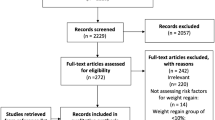Background: Adjustable gastric banding and esophagogastric banding may affect the function of the lower esophageal sphincter (LES) and esophageal motility in the long-term. Both methods were evaluated in a prospective randomized trial. Materials and Methods: Group 1 comprised 28 patients who underwent laparoscopic adjustable gastric banding and Group 2 consisted of 24 patients in whom adjustable esophagogastric banding was performed. Swedish Adjustable Gastric Bands® were used in all patients. Body mass index (BMI), perioperative complications and reflux symptoms were assessed and upper gastrointestinal endoscopy, esophageal barium studies, esophageal manometry and 24-hour esophageal pH-monitoring were performed pre- and postoperatively. 18 (Group 1) and 14 (Group 2) patients completed the postoperative follow-up procedure after a median of 23 and 24 months, respectively. Results: Postoperatively the median BMI dropped equally in both groups. Perioperative complications requiring re-intervention were significantly more frequent in Group 2 than in Group 1. Heartburn improved equally in both groups following surgery; however, regurgitation and esophagitis were significantly more common in Group 2 than in Group 1.24-hour esophageal pH-monitoring and the LES resting pressure improved equally in both groups, but there was a significant impairment of the LES relaxation and the esophageal peristalsis, which was more pronounced in Group 2 than in Group 1. This caused significant esophageal stasis as shown by barium studies. Conclusions: Both techniques, gastric and esophagogastric banding, provide effective weight loss in morbidly obese patients but affect the esophagogastric junction. Although both procedures strengthen the antireflux-barrier, LES relaxation becomes impaired, thus promoting esophageal dilatation and esophageal stasis. This is more pronounced following esophagogastric banding than following the classic procedure. Since the esophagogastric banding results in more complications requiring re-intervention, we believe that this procedure should not be used any more.
Similar content being viewed by others
Author information
Authors and Affiliations
Rights and permissions
About this article
Cite this article
Weiss, H.G., Nehoda, H., Labeck, B. et al. Adjustable Gastric and Esophagogastric Banding: A Randomized Clinical Trial. OBES SURG 12, 573–578 (2002). https://doi.org/10.1381/096089202762252370
Published:
Issue Date:
DOI: https://doi.org/10.1381/096089202762252370




